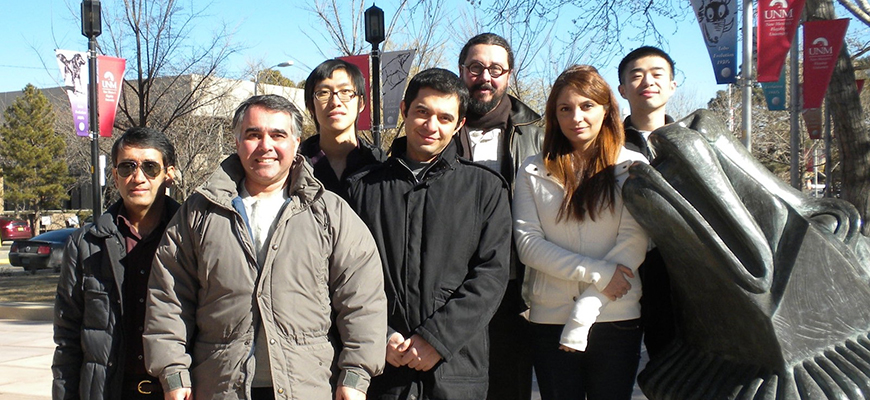Recent News
November 21 Seminar: Jim Aarestad
November 19, 2025
November 14 seminar: Manel Martínez-Ramón
November 12, 2025
November 7 seminar: Bradley Ratliff
November 5, 2025
October 31 seminar: Adarsh Venkataramani
October 29, 2025
News Archives
Professors Hayat, Mammoli and Ghani win $1.05M grant from DTRA to Support Smart Grid Research
February 18, 2013 - Charles Reuben
 Professors Majeed Hayat, Andrea Mammoli and Nasir Ghani have recently received a three-year $1.05 million grant from the Defense Threat Reduction Agency (DTRA) to support basic research on understanding cascading failures in modern power grids. Their project, titled “Probabilistic Characterization of Precursors to WMD-induced Cascading Failures in the Electric-cyber Infrastructure,” aims is to build a probabilistic theory that offers a fundamental understanding of cascading failures in complex, information-centric power grids, or smart grids, under large-scale and geographically-correlated stressors resulting from natural disasters and/or weapons of mass destructions (WMD) in particular. Their proposed approach will integrate stochastic behaviors at the power grid transmission layer (due to the dynamic nature of loads and power sources, as well as random external stresses) with stochastic behaviors in the communication/control networks (due to uncertainty in traffic conditions and stochastic failures/recoveries of links and control nodes). Furthermore, the impact of critical human factors, such as indecision, panic, delay, etc., will also be modeled. In particular, the human behavioral aspect of the research will be conducted in collaboration with Dr. Olga Sachs at the Fraunhofer Center for Sustainable Systems in Cambridge, MA. UNM graduate students Mahshid Rahnamay-Naeini, Zhuoyao Wang, Yaser Yasaei and Hao Bai will be actively working with the PIs on this project.
Professors Majeed Hayat, Andrea Mammoli and Nasir Ghani have recently received a three-year $1.05 million grant from the Defense Threat Reduction Agency (DTRA) to support basic research on understanding cascading failures in modern power grids. Their project, titled “Probabilistic Characterization of Precursors to WMD-induced Cascading Failures in the Electric-cyber Infrastructure,” aims is to build a probabilistic theory that offers a fundamental understanding of cascading failures in complex, information-centric power grids, or smart grids, under large-scale and geographically-correlated stressors resulting from natural disasters and/or weapons of mass destructions (WMD) in particular. Their proposed approach will integrate stochastic behaviors at the power grid transmission layer (due to the dynamic nature of loads and power sources, as well as random external stresses) with stochastic behaviors in the communication/control networks (due to uncertainty in traffic conditions and stochastic failures/recoveries of links and control nodes). Furthermore, the impact of critical human factors, such as indecision, panic, delay, etc., will also be modeled. In particular, the human behavioral aspect of the research will be conducted in collaboration with Dr. Olga Sachs at the Fraunhofer Center for Sustainable Systems in Cambridge, MA. UNM graduate students Mahshid Rahnamay-Naeini, Zhuoyao Wang, Yaser Yasaei and Hao Bai will be actively working with the PIs on this project.
Background:
Today’s electric grid is becoming increasingly fragile, partly due to the lack of infrastructure investment. Operators have also become more adept at operating the grid near its physical limits by taking advantage of advances in communications and data processing. However, these gains have come at the expense of robustness and reliability, since the correct functioning of the grid depends not only on the integrity of the power infrastructure but also on the communications network. Recently, there has also been a shift toward increasing the contribution of distributed energy resources in the energy mix. One of the challenges here is the need to introduce more distributed, two-way control to enable a high penetration of such distributed resources, which in many cases would be intermittent and non-dispatchable, e.g., solar power. However, distributed control and generation, in combination with distributed storage, could also result in a more resilient system, especially in the face of WMD attacks, as long as the control actions take into account possible degradation in the communication/control infrastructure and disruptions due to human error. This distributed evolution of the system is assumed in this project.
In light of the above, a key high-level challenge is to quantitatively address the relative roles of automation and human supervision in decision-making processes in modern power grids. For example, the 2003 Northeast blackout provides a textbook example of the complex interaction of human, computer and grid events. Here, a mishandled restart of a monitoring system led to a sequence of undetected failures. Subsequent corrective load-shedding actions were also delayed as the operator had never seen requests of such a magnitude and was unaware of the rapidly developing crisis. Another key question that arises is whether more automation should be allowed so that corrective actions may be executed more rapidly and effectively, albeit at the risk of encountering unforeseen computer/communication failures that could be averted by human judgment. Yet another concern is possible reduced rationality during a stressful crisis, such as a WMD attack.
How can we understand cascading failures?
Modern power infrastructures, including smart grids, comprise of three interacting and inter-dependent networks: a power grid, a control/communication network, and a social network of human agents managing or utilizing the power grid. Large cascading failures in transmission grids can be triggered by a combination of initial failures and lack of proper corrective actions. Initial disturbances can be due to natural disasters, human faults or WMD attacks, which bear the added attribute of yielding possibly larger and more-coordinated spatial and temporal correlation in damaged areas. A key objective of this multidisciplinary project is to build a probabilistic theory to yield a fundamental understanding of cascading failures in large-scale, information-centric power grids under stress from natural disasters and WMD events. The approach is based on a reduced abstraction of large-scale power infrastructure by means of finite “aggregate” state variables and modeling of the system dynamics based upon a stochastic-state machine approach. The project envisions the identification of a critical, low-dimensional manifold of power-grid and communication/control network parameters, as well as quantitative human-factor attributes, that separates cascading behavior from non-cascading behavior in response to large-scale disturbances. The scientific understanding of cascading behaviors will be used to guide the design of control policies at the distribution and transmission levels, as well as communication networks, for robustness of the grid to WMD-induced failures and ensuing human errors.
